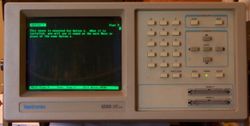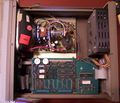1220: Difference between revisions
No edit summary |
No edit summary |
||
| (22 intermediate revisions by 3 users not shown) | |||
| Line 1: | Line 1: | ||
{{ | {{Instrument Sidebar | ||
|class=Logic Analyzer | |||
image= | |manufacturer=Tektronix | ||
caption=Tektronix 1220| | |model=1220 | ||
introduced= | |image=1220pic1.jpg | ||
discontinued= | |caption=Tektronix 1220 | ||
summary=32 channel logic analyzer| | |introduced=1988 | ||
manuals= | |discontinued=1993 | ||
* [ | |summary=32 channel logic analyzer | ||
* [[Media: | |manuals= | ||
* [[Media:070-6438-02.pdf|1220/1225 Operator Manual]] | |||
* [[Media:061-3473-00.pdf|1220/1225 Service Manual]] | |||
* [[Media:070-7219-00.pdf|Learning to use a LOGIC ANALYZER]] (OCR) | |||
====ROM images==== | |||
* [[Media:160-5530-00.BIN|160-5530-00]] | |||
* [[Media:160-5531-01.BIN|160-5531-00]] | |||
}} | }} | ||
The '''Tektronix 1220''' is a logic analyzer [[introduced in 1988]] that supports 16 to 32 channels, 100 MHz asynchronous, 25 MHz synchronous. It is equivalent to the Tektronix [[1225]] but has two 16-bit probe ports instead of three. It is also very similar to the to the Tektronix [[1230]]. | |||
The '''Tektronix 1220''' is a logic analyzer that supports 16 to 32 channels, 100 MHz asynchronous, 25 MHz synchronous | |||
The 1220/1230 series was an effort by Tektronix to make an "easy to use" logic analyzer aimed at students and engineers. The user interface clearly represents that mindset. The menus are simple and there are help guides everywhere guiding the user in what he might want to do. | |||
The 1220 did not have the same expansion capability that the [[1230]] had. The only expansion available were the option boards, of which four were available − [[parallel printer interface]], [[RS-232 interface]], [[GPIB interface]], and on-line notes in foreign languages. Tektronix also had a software package (S43R101) that would run on IBM PC compatible machines. | |||
A test card was supplied with the analyzer [[671-0049-00]]. | |||
See the [[Microprocessor support table]] for microprocessor disassembly configuration options. | |||
{{BeginSpecs}} | {{BeginSpecs}} | ||
{{Spec | Probes | either [[P6442]], [[P6443]] or [[P6444]] (16-channel) }} | |||
{{Spec | Number of channels | 32 channels }} | {{Spec | Number of channels | 32 channels }} | ||
{{Spec | CRT | 13 x 10 cm }} | {{Spec | CRT | 13 x 10 cm }} | ||
| Line 27: | Line 39: | ||
{{EndSpecs}} | {{EndSpecs}} | ||
== | ==Internals== | ||
The 1220 is built around a [[MOS Technology 6502|65C02]] as the control processor along with SRAM, and 64K of firmware in a bank of EPROMs. There is a separate board under it that manages the display and keypad, which is powered by another 65C02 CPU and is using an MC68A45 CRT controller to drive the display. The display board has 56K of RAM and 8K of ROM, with two coin cell batteries to retain settings. | |||
There is a bug that prevents the 1220 from keeping the date after the year 2000. Upon powering it off and on again it will revert to 19xx, e.g. 2018 will turn into 1918. | |||
The keypad switches have a tendency to become very "bouncy". See the "repair" tab. | |||
===Easter egg=== | |||
An "Easter egg" can be activated in the 1220 by pressing the STOP button when the welcome screen shows during power-up. A bar with the programmers' names will display near the bottom of the screen. | |||
== Links == | == Links == | ||
* [http://www.neufeld.newton.ks.us/electronics/?p=111|Tek 1220 Page on Keith's Electronics Blog] | * [http://www.neufeld.newton.ks.us/electronics/?p=111|Tek 1220 Page on Keith's Electronics Blog] | ||
==Pictures == | |||
<gallery> | <gallery> | ||
Tek 1220.jpg | Tek 1220.jpg | ||
1220pic2.jpg | |||
Tek 1225board5.JPG | |||
Tek 1225board6.JPG | |||
Tek 1225board7.JPG | |||
Tek 1225board3.JPG | |||
</gallery> | </gallery> | ||
Thanks to Keith Neufeld for the pictures! | |||
==Components== | |||
{{Parts|1220}} | |||
[[Category: Logic | [[Category:Logic analyzers]] | ||
[[Category:Parallel printer interface]] | |||
[[Category:RS-232 interface]] | |||
[[Category:GPIB interface]] | |||
Latest revision as of 13:46, 14 June 2024
The Tektronix 1220 is a logic analyzer introduced in 1988 that supports 16 to 32 channels, 100 MHz asynchronous, 25 MHz synchronous. It is equivalent to the Tektronix 1225 but has two 16-bit probe ports instead of three. It is also very similar to the to the Tektronix 1230.
The 1220/1230 series was an effort by Tektronix to make an "easy to use" logic analyzer aimed at students and engineers. The user interface clearly represents that mindset. The menus are simple and there are help guides everywhere guiding the user in what he might want to do.
The 1220 did not have the same expansion capability that the 1230 had. The only expansion available were the option boards, of which four were available − parallel printer interface, RS-232 interface, GPIB interface, and on-line notes in foreign languages. Tektronix also had a software package (S43R101) that would run on IBM PC compatible machines. A test card was supplied with the analyzer 671-0049-00.
See the Microprocessor support table for microprocessor disassembly configuration options.
Key Specifications
| Probes | either P6442, P6443 or P6444 (16-channel) |
|---|---|
| Number of channels | 32 channels |
| CRT | 13 x 10 cm |
| Power | 90-250 V |
| Weight | 8.2 kg (18 lb.) |
| Features |
|
Internals
The 1220 is built around a 65C02 as the control processor along with SRAM, and 64K of firmware in a bank of EPROMs. There is a separate board under it that manages the display and keypad, which is powered by another 65C02 CPU and is using an MC68A45 CRT controller to drive the display. The display board has 56K of RAM and 8K of ROM, with two coin cell batteries to retain settings.
There is a bug that prevents the 1220 from keeping the date after the year 2000. Upon powering it off and on again it will revert to 19xx, e.g. 2018 will turn into 1918.
The keypad switches have a tendency to become very "bouncy". See the "repair" tab.
Easter egg
An "Easter egg" can be activated in the 1220 by pressing the STOP button when the welcome screen shows during power-up. A bar with the programmers' names will display near the bottom of the screen.
Links
Pictures
Thanks to Keith Neufeld for the pictures!
Components
Some Parts Used in the 1220
| Part | Part Number(s) | Class | Description | Used in |
|---|---|---|---|---|
| MOS Technology 6502 | 156-1425-00 | Monolithic integrated circuit | 8-bit microprocessor | 1220 • 1225 • 1230 • DC5010 |






